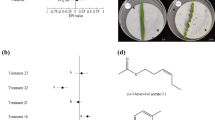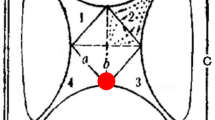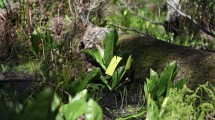Abstract
The redbay ambrosia beetle, Xyleborus glabratus, is an important pest of redbay (Persea borbonia) and swamp bay (P. palustris) trees in forests of the southeastern USA. It is also a threat to commercially grown avocado. The beetle is attracted to host wood volatiles, particularly sesquiterpenes. Contrary to other ambrosia beetles that attack stressed, possibly pathogen-infected, and dying trees, X. glabratus readily attacks healthy trees. To date little is known about the role of leaf volatiles in the host selection behavior and ecology of X. glabratus. To address this question, an olfactometer bioassay was developed to test the behavioral response of X. glabratus to plant leaf volatiles. We found that X. glabratus was attracted to the leaf odors of their hosts, redbay and swamp bay, with no attraction to a non-host tree tested (live oak, Quercus virginiana), which served as a negative control. Gas chromatography–mass spectrometry (GS/MS) analysis of leaves revealed the absence of sesquiterpenes known to be attractive to X. glabratus and present in host wood, suggesting that additional leaf-derived semiochemicals may serve as attractants for this beetle. An artificial blend of chemicals was developed based on GC/MS analyses of leaf volatiles and behavioral assays. This blend was attractive to X. glabratus at a level that rivaled currently used lures for practical monitoring of this pest. This synthetic redbay leaf blend also was tested in the field. Baited traps captured more X. glabratus than unbaited controls and equivalently to manuka oil lures. We hypothesize that leaf volatiles may be used by X. glabratus as an additional cue for host location.




Similar content being viewed by others
References
Baldwin IT (2010) Plant volatiles. Curr Biol 20:R392–R397
Brar GS, Capinera JL, McLean S, Kendra PE, Ploetz RC, Peña JE (2012) Effect of trap size, trap height and age of lure on sampling xyleborus glabratus (coleoptera: curculionidae: scolytinae), and its flight periodicity and seasonality. Fla Entomol 95:1003–1011
Brenna E, Fuganti C, Stefano S (2003) Enantioselective perception of chiral odorants. Tetrahedron Asymmetry 14:1–42
Byers JA, Zhang QH, Birgersson G (2000) Strategies of a bark beetle, pityogenes bidentatus, in an olfactory landscape. Naturwissenschaften 87:503–507
Duduman ML (2014) Field response of the northern spruce bark beetle Ips duplicatus (sahlberg) (coleoptera: curculionidae, scolytinae) to different combinations of synthetic pheromone with (−) ‐α‐pinene and (+)-limonene. Agric For Entomol 16:102–109
Evans JP, Scheffers BR, Hess M (2013) Effect of laurel wilt invasion on redbay populations in a maritime forest community. Biol Invasions 16:1581–1588
Fraedrich SW, Harrington TC, Rabaglia RJ, Ulyshen MD, Mayfield AE, Hanula JL, Eickwort JM, Miller DR (2008) A fungal symbiont of the redbay ambrosia beetle causes a lethal wilt in redbay and other lauraceae in the southeastern United States. Plant Dis 92:215–224
Hanula JL, Sullivan B (2008) Manuka oil and phoebe oil are attractive baits for xyleborus glabratus (coleoptera : scolytinae), the vector of laurel wilt. Environ Entomol 37:1403–1409
Hanula JL, Mayfield AE, Fraedrich SW, Rabaglia RJ (2008) Biology and host associations of redbay ambrosia beetle (coleoptera: curculionidae: scolytinae), exotic vector of laurel wilt killing redbay trees in the southeastern United States. J Econ Entomol 101:1276–1286
Hanula JL, Sullivan BT, Wakarchuk D (2013) Variation in manuka oil lure efficacy for capturing xyleborus glabratus (coleoptera: curculionidae: scolytinae), and cubeb oil as an alternative attractant. Environ Entomol 42:333–340
Harrington TC, Fraedrich SW, Aghayeva DN (2008) Raffaelea lauricola, a new ambrosia beetle symbiont and pathogen on the lauraceae. Mycotaxon 104:399–404
Hughes MA, Smith JA (2014) Vegetative propagation of putatively laurel wilt-resistant redbay (persea borbonia). Native Plants J 15:42–50
Hughes MA, Smith J, Ploetz R, Kendra P, Mayfield AE, Hanula J, Hulcr J, Stelinski L, Cameron S, Riggins J, Carrillo D, Rabaglia B, Eickwort J, Pernas T (2015) Recovery plan for laurel wilt on redbay and other forest species caused by raffaelea lauricola and disseminated by xyleborus glabratus. National Plant Disease Recovery System, Homeland Security Presidential Directive Number 9 (HSPD-9)
Hulcr J, Lou Q-Z (2013) The redbay ambrosia beetle (coleoptera: curculionidae) prefers lauraceae in its native range: records from the Chinese national insect collection. Fla Entomol 96:1595–1596
Hulcr J, Mogia M, Isua B, Novotny V (2007) Host specificity of ambrosia and bark beetles (col: curculionidae: scolytinae and platypodinae) in a New Guinea rainforest. Ecol Entomol 32:762–772
Hulcr J, Mann R, Stelinski LL (2011) The scent of a partner: ambrosia beetles are attracted to volatiles from their fungal symbionts. J Chem Ecol 37:1374–1377
Johnson C, Cameron R, Hanula J, Bates C (2014) The attractiveness of manuka oil and ethanol, alone and in combination, to xyleborus glabratus (coleoptera: curculionidae: scolytinae) and other curculionidae. Fla Entomol 97:861–864
Kelsey RG, Gallego D, Sánchez-García FJ, Pajares JA (2014) Ethanol accumulation during severe drought may signal tree vulnerability to detection and attack by bark beetles. Can J For Res 44:554–561
Kendra PE, Montgomery WS, Niogret J, Deyrup MA, Guillén L, Epsky ND (2012) Xyleborus glabratus, X. affinis, and X. ferrugineus (coleoptera: curculionidae: scolytinae): electroantennogram responses to host-based attractants and temporal patterns in host-seeking flight. Environ Entomol 41:1597–1605
Kendra PE, Montgomery WS, Niogret J, Pruett GE, Mayfield AE, MacKenzie M, Deyrup MA, Bauchman GR, Ploetz RC, Epsky ND (2014a) North American lauraceae: terpenoid emissions, relative attraction and boring preferences of redbay ambrosia beetle, xyleborus glabratus (coleoptera: curculionidae: scolytinae). PLoS One 9, e102086
Kendra PE, Montgomery WS, Niogret J, Schnell EQ, Deyrup MA, Epsky ND (2014b) Evaluation of seven essential oils identifies cubeb oil as most effective attractant for detection of xyleborus glabratus. J Pest Sci 87:681–689
Kendra PE, Niogret J, Montgomery WS, Deyrup MA, Epsky ND (2015) Cubeb oil lures: terpenoid emissions, trapping efficacy, and longevity for attraction of redbay ambrosia beetle (Coleoptera: Curculionidae: Scolytinae). J Econo Entomol. doi:10.1093/jee/tou023
Kimmerer TW, Kozlowski TT (1982) Ethylene, ethane, acetaldehyde, and ethanol production by plants under stress. Plant Physiol 69:840–847
Kuhns EH, Martini X, Tribuiani Y, Coy M, Gibbard C, Peña J, Hulcr J, Stelinski LL (2014a) Eucalyptol is an attractant of the redbay ambrosia beetle, xyleborus glabratus. J Chem Ecol 40:355–362
Kuhns EH, Tribuiani Y, Martini X, Meyer WL, Peña J, Hulcr J, Stelinski LL (2014b) Volatiles from the symbiotic fungus raffaelea lauricola are synergistic with manuka lures for increased capture of the redbay ambrosia beetle xyleborus glabratus. Agric For Entomol 16:87–94
Li Q, Wang XX, Lin JG, Liu J, Jiang MS, Mao-Sheng J, Chu LX (2014) Chemical composition and antifungal activity of extracts from the xylem of cinnamomum camphora. Bioresources 9:2560–2571
Lindgren BS (1990) Ambrosia beetles. J For 88:8–11
Maner ML, Hanula JL, Braman SK (2013) Gallery productivity, emergence, and flight activity of the redbay ambrosia beetle (coleoptera: curculionidae: scolytinae). Environ Entomol 42:642–647
Mayfield AE III, Brownie C (2013) The redbay ambrosia beetle (coleoptera: curculionidae: scolytinae) uses stem silhouette diameter as a visual host-finding cue. Environ Entomol 42:743–50
Mayfield AE III, Peña JE, Crane JH, Smith JA, Branch CL, Ottoson ED, Hughes M (2008) Ability of the redbay ambrosia beetle (coleoptera: curculionidae: scolytinae) to bore into young avocado (lauraceae) plants and transmit the laurel wilt pathogen (raffaelea lauricola). Fla Entomol 91:485–487
Mayfield AE III, MacKenzie M, Cannon PG, Oak SW, Horn S, Hwang J, Kendra PE (2013) Suitability of California bay laurel and other species as hosts for the non-native redbay ambrosia beetle and granulate ambrosia beetle. Agric For Entomol 15:227–235
McLeod G, Gries R, von Reuß SH, Rahe JE, McIntosh R, König WA, Gries G (2005) The pathogen causing Dutch elm disease makes host trees attract insect vectors. Proc R Soc B 272:2499–2503
Miller DR, Rabaglia RJ (2009) Ethanol and (−)-alpha-pinene: attractant kairomones for bark and ambrosia beetles in the southeastern US. J Chem Ecol 35:435–48
Miller DR, Dodds KJ, Eglitis A, Fettig CJ, Hofstetter RW, Langor DW, Mayfield AE, Munson AS, Poland TM, Raffa KF (2013) Trap lure blend of pine volatiles and bark beetle pheromones for monochamus spp. (coleoptera: cerambycidae) in pine forests of canada and the United States. J Econ Entomol 106:1684–1692
Montgomery ME, Wargo PM (1983) Ethanol and other host-derived volatiles as attractants to beetles that bore into hardwoods. J Chem Ecol 9:181–90
Mori K (2014) Stereochemical studies on pheromonal communications. Proc Jpn Acad Ser B 90:373–388
Niogret J, Kendra PE, Epsky ND, Heath RR (2011) Comparative analysis of terpenoid emissions from Florida host trees of the redbay ambrosia beetle, xyleborus glabratus (coleoptera: curculionidae: scolytinae). Fla Entomol 94:1010–1017
Niogret J, Epsky ND, Schnell RJ, Boza EJ, Kendra PE, Heath RR (2013) Terpenoid variations within and among half-sibling avocado trees, persea americana mill. (lauraceae). PLoS One 8, e73601
Peña JE, Carrillo D, Duncan RE, Capinera JL, Brar G, McLean S, Arpaia ML, Focht E, Smith JA, Hughes M, Kendra PE (2012) Susceptibility of persea spp. and other lauraceae to attack by redbay ambrosia beetle, xyleborus glabratus (coleoptera : curculionidae: scolytinae). Fla Entomol 95:783–787
Ploetz RC, Hulcr J, Wingfield M, de Beer ZW (2013) Ambrosia and bark beetle-associated tree diseases: black swan events in tree pathology? Plant Dis 95:856–872
Ponzio C, Gols R, Pieterse CM, Dicke M (2013) Ecological and phytohormonal aspects of plant volatile emission in response to single and dual infestations with herbivores and phytopathogens. Funct Ecol 27:587–598
Rabaglia RJ, Dole SA, Cognato AI (2006) Review of American xyleborina (coleoptera: curculionidae: scolytinae) occurring north of mexico, with an illustrated key. Ann Entomol Soc Am 99:1034–1056
Ranger CM, Reding ME, Persad AB, Herms DA (2010) Ability of stress-related volatiles to attract and induce attacks by xylosandrus germanus and other ambrosia beetles. Agric For Entomol 12:177–185
Rodgers L, Derksen A, Pernas T (2014) Expansion and impact of laurel wilt in the Florida everglades. Fla Entomol 97:1247–1250
Scora R, Bergh B (1992) in Proceedings of Second World Avocado Congress, pp 505–514
Shields J, Jose S, Freeman J, Bunyan M, Celis G, Hagan D, Morgan M, Pieterson EC, Zak J (2011) Short-term impacts of laurel wilt on redbay (persea borbonia L. spreng.) in a mixed evergreen-deciduous forest in northern Florida. J For 109:82–88
Spiegel KS, Leege LM (2013) Impacts of laurel wilt disease on redbay (persea borbonia [L.] spreng.) population structure and forest communities in the coastal plain of Georgia, USA. Biol Invasions 15:2467–2487
Turlings TC, Wäckers F (2004) Recruitment of predators and parasitoids by herbivore-injuried plants. In: Carde RT, Millar GM (eds) Advance in insect chemical ecology. Cambridge University Press, Cambridge, UK, pp 21–75
Unelius CR, Schiebe C, Bohman B, Andersson MN, Schlyter F (2014) Non-host volatile blend optimization for forest protection against the European spruce bark beetle, Ips typographus. PLoS One 9, e85381
Vet LEM, van Lenteren JC, Hetmans M, Meelis E (1983) An airflow olfactometer for measuring olfactory responses of hymenopterous parasitoids and other small insects. Physiol Entomol 8:97–106
Zar J (2009) Biostatisical analysis, 5th edn. Prentice Hall, Upper Saddle River, NJ
Zhang Q-H, Schlyter F (2004) Olfactory recognition and behavioural avoidance of angiosperm nonhost volatiles by conifer-inhabiting bark beetles. Agric For Entomol 6:1–20
Acknowledgments
We thank Adam Black for acquiring infested swamp bay logs for emergence; Kelsey Olson for help with Fig. 1; Angelique Hoyte, Laurie Martini, and Barry Fleming for help with behavioral assays. Funding was provided by the USDA Forest Service (Region 8) [Marc Hughes and Jason Smith] and USDA-APHIS grant (Cooperative Agreement 13-8212-0990-CA) [Lukas L. Stelinski].
Author information
Authors and Affiliations
Corresponding author
Additional information
Xavier Martini and Marc A. Hughes contributed equally to this work.
Rights and permissions
About this article
Cite this article
Martini, X., Hughes, M.A., Smith, J.A. et al. Attraction of Redbay Ambrosia Beetle, Xyleborus Glabratus, To Leaf Volatiles of its Host Plants in North America. J Chem Ecol 41, 613–621 (2015). https://doi.org/10.1007/s10886-015-0595-5
Received:
Revised:
Accepted:
Published:
Issue Date:
DOI: https://doi.org/10.1007/s10886-015-0595-5




